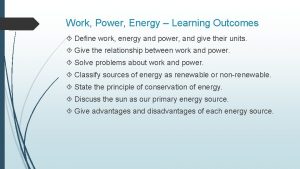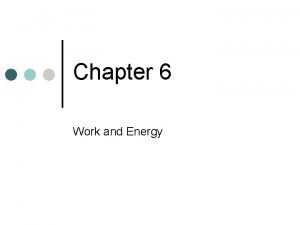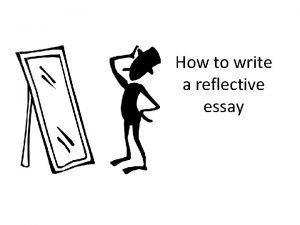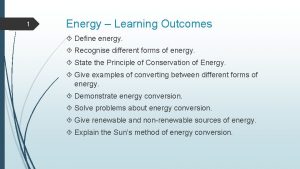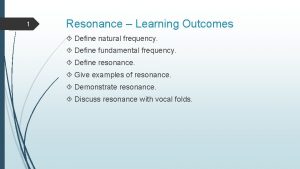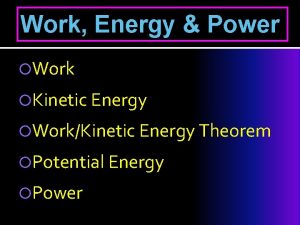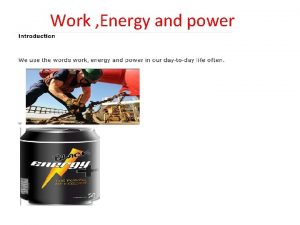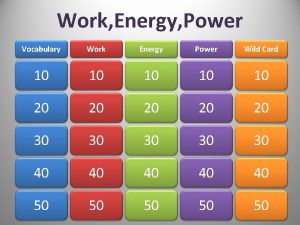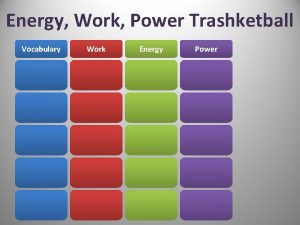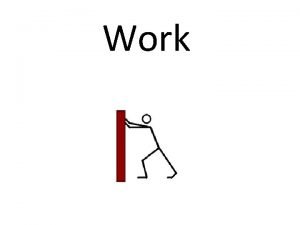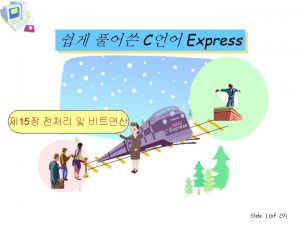1 Work Power Energy Learning Outcomes Define work



















- Slides: 19

1 Work, Power, Energy – Learning Outcomes Define work, energy and power, and give their units. Give the relationship between work and power. Solve problems about work and power. Classify sources of energy as renewable or non-renewable. State the principle of conservation of energy.

2 Work, Energy, Power – Learning Outcomes Discuss the sun as our primary energy source. Give advantages and disadvantages of each energy source. Identify forms of energy.

3 Work, Energy, Power – Learning Outcomes Show some energy conversions: chemical to electrical to heat energy. electrical to magnetic to kinetic energy. light to electrical to kinetic energy. Give examples of energy conversion from everyday experience.

4 Work

5 Work e. g. Rachel pushes a shopping trolley with a force of 400 N a distance of 25 m. What work was done? e. g. Sasha wants to beat the current Olympic record for the snatch weightlift. She needs to lift at least 215 kg above her head in one fluid motion. How much work does she need to put in? e. g. 100 J is used to move an object 20 m. What force was needed?

6 Power

7 Power e. g. 200 J of work is done on an object over 5 seconds. Calculate the average power needed. e. g. How much power is needed when a force of 15 N moves an object a distance of 40 cm in 3 seconds? e. g. Anastacia’s world record attempt takes a total of 6 seconds. What was the average power needed?

8 Energy is the ability to do work. Unit of energy is joule (J). Energy comes in several forms: Kinetic Electrical Potential Magnetic Sound Light Heat Nuclear Chemical

9 Energy The Principle of Conservation of Energy states that energy can be neither created nor destroyed, but can be converted from one form to another.

10 Energy e. g. listening to music: electrical -> sound e. g. driving a car chemical -> kinetic e. g. making toast: electrical -> heat and light e. g. a falling object: potential -> kinetic

11 Energy e. g. humans need food to survive because we use the chemical energy stored in food. Our bodies convert it to different types of energy depending on what we need it for: kinetic energy to move sound energy to speak heat energy to keep warm electrical energy to send signals to and from the brain light energy to radiate infra-red back to chemical energy to make enzymes, proteins etc.

12 Powering the Country The electricity in the country comes from the National Grid. Some companies like ESB, Gas Networks Ireland, and Airtricity produce electricity and add it to the grid. Other companies and people then buy their electricity from the Grid through these electricity producers. Each company produces electricity in different ways.

13 Sources of Electricity sources can be classified as either renewable or non-renewable. Non-renewable sources of energy are things like fossil fuels and nuclear fuels – there is a limited amount of fuel available that will eventually run out. Renewable sources will never run out, as they are constantly being provided by the earth.

14 Sources of Electricity – non-Renewable Fossil fuels: Advantages • Easy to get • Relatively cheap Disadvantages • Produce harmful greenhouse gases • Limited supply Nuclear power comes in two forms – fission and fusion. Fusion is hard and is not yet usable. Fission is what most people mean when they say nuclear power. Advantages • High energy output • Quite safe Disadvantages • Some dangers due to radioactive fuel and waste • Possibility of explosion

15 Sources of Energy - Renewable sources will always be available, but some take more effort to produce or harvest. Solar energy: Advantages • Free • No pollution Disadvantages • Solar cells are expensive to make • Current technology is inefficient Hydro-Electricity Advantages • Cost efficient • No pollution Disadvantages • Can upset the local area with flooding or diverting water

16 Sources of Energy - Renewable Wind energy Advantages • Free • No air pollution Disadvantages • Requires windy days to be effective • Cause noise and may be an eye sore Tidal / wave energy Advantages • Free • No pollution Disadvantages • Can be harmful to marine animals and plants • Difficult to maintain

17 Sources of Energy - Renewable Geothermal energy Advantages • Free Disadvantages • Can cause pollution Biomass energy Advantages Disadvantages • Can produce other • Requires large areas of land to grow useful materials crops • Can cause pollution • Many crops are seasonal

18 The Sun Ultimately, most sources of energy on the planet come from the Sun: fossil fuels come from dead plants and animals that lived many years ago – needed the Sun to live and produce food. plants we grow for food or burning need the Sun for photosynthesis wind and tidal energy are produced when the Sun’s light affects our weather all heavy atoms used in nuclear energy were produced in dying stars hydro-electric energy comes from falling water which was lifted by the Sun as part of the water cycle.

19 Conserving Energy Demand cost of energy is rising. Supply of cheap fossil fuels is getting smaller. Install energy saving light bulbs. Switch off appliances and bulbs when not using them. Use public transport or cycle to school/work. Install better insulation in homes.
 Sound energy definition
Sound energy definition Learning outcomes of work and energy
Learning outcomes of work and energy Work and power definition
Work and power definition Power trianlge
Power trianlge Examples of learning outcomes
Examples of learning outcomes Water cycle learning outcomes
Water cycle learning outcomes Notice lesson plan
Notice lesson plan Objective of swot analysis
Objective of swot analysis Importance of nursery rhymes
Importance of nursery rhymes Planning goals and learning outcomes
Planning goals and learning outcomes Photosynthesis takes place in
Photosynthesis takes place in Learning objectives of nutrition in plants class 7
Learning objectives of nutrition in plants class 7 7 domain of ncbts
7 domain of ncbts Learning outcomes of linear equations in one variable
Learning outcomes of linear equations in one variable Learning outcomes generator
Learning outcomes generator Objectives of reported speech
Objectives of reported speech Purpose of learning outcomes
Purpose of learning outcomes Modern input devices
Modern input devices Mri ib psychology
Mri ib psychology How to write a reflective essay
How to write a reflective essay
